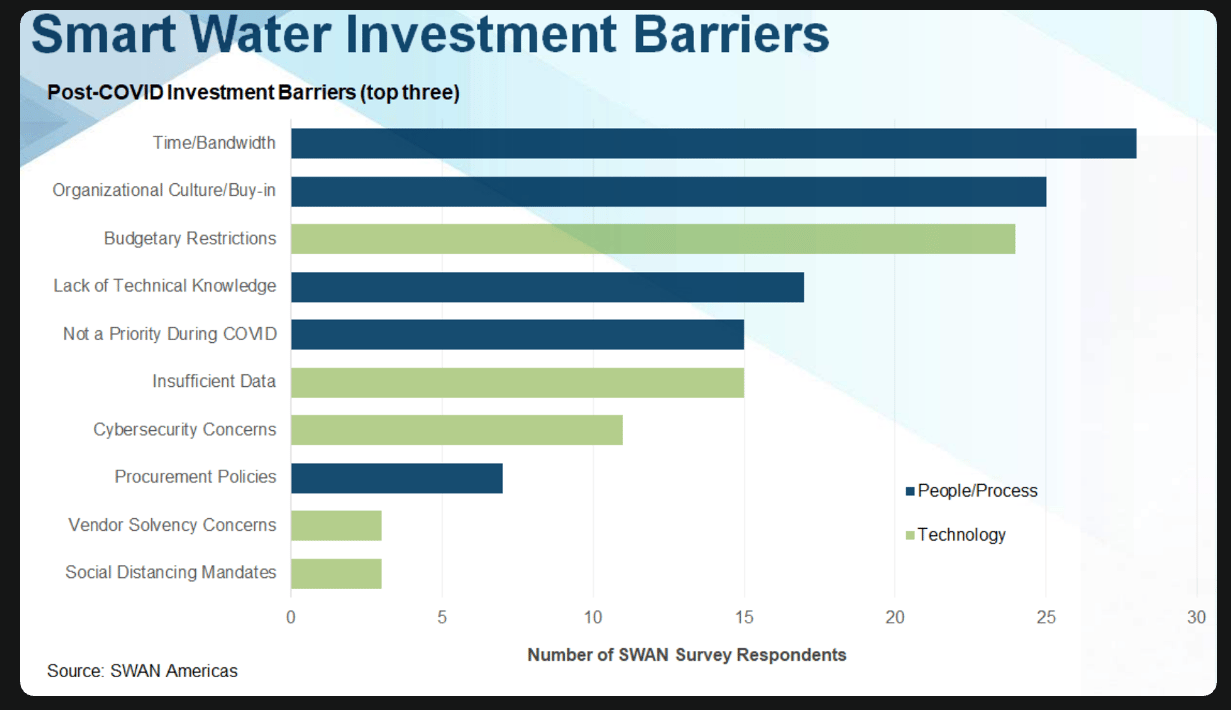- Infrasync Technology Services
- Posts
- Infrasync Newsletter #7 - How to get internal support for any smart utility project
Infrasync Newsletter #7 - How to get internal support for any smart utility project
When I saw this study from Smart Water Alliance Network I just about fell out of my chair! The barriers to adopting smart water technology isn’t just financial cost or cybersecurity. The biggest barriers are internal obstacles! In other words what is keeping utilities back isn’t the financial cost but the time cost.

How can someone trying to improve their utility make use of this? Start by understanding that while financial cost is an issue. It’s typically not the driving factor. How can you win the hearts and minds of others around the utility to take a more digital approach to solving water utility problems?
It can take months to get your team aligned, what has worked well for me is to take a phased approach.
Phase 1 – Identify the Goal and Approach
Sharpen your pencil and write down what is the big goal you want to solve. This can range from a long ignored strategic issue such as assessing every waterline in your system or it can look like meeting a new regulation such as PFAS destruction at your water treatment plants. Regardless of the goal you can use the following format.
Formula
We want to achieve [GOAL] using [APPROACH] because it will [IMPACT OF GOAL]. Otherwise [CONSEQUENCE] will happen.
Example - Waterlines
We want to achieve a goal of assessing 95% of the waterlines in our system using external sensors for small diameters lines and internal robotics for larger diameter lines. This will allow us to better spend our capital pipeline replacement budget of $10,000,000 annually and reduce our non-revenue water from 26% to 22% over 5 years. If we do not take this approach we will spend the same budget of $10,000,000 annually with the non-revenue water staying flat at 26% over the next 5 years.
Example - Treatment
We want to reduce decision time lag at our primary treatment plants using better databases and software to collect field reports and lab samples. This will allow us to better monitor equipment and sampling that is trending in the wrong direction and reduce our number of violations from 6 to 1 annually. Each violation is a $10,000 fine and about 400 manhours of effort to report and correct. If we do not take this approach we will continue to see fines and manhours lost each year.
Phase 2 – Figure out the true cost to implement
Formula
To address this we estimate [TECH] will take [TIME], take [JOB ADJUSTMENTS], and take [COSTS].
Example - Waterlines
To achieve this goal of using external sensors for small diameters lines and internal robotics for larger diameter lines. We estimate it will take 6 months to make selections, 400 hours to select and implement, 100 hours of annual additional work to manage and use the data. This will be managed by John in Operations and his team. The estimates range from $400,000 to $600,000 annually.
Example - Treatment
To achieve this goal of using better databases and software to collect field reports and lab samples we estimate it will take 3 months to make selections. 80 hours to select and implement. Sarah from Operations and her team will manage and own this process. We will also need Travis from IT to assist with configuring the database. The estimates range from $60,000 to $80,000 annually.
BONUS – Be proactive and identify which other technology is already in place to work with or other new proposed technology to integrate all at the same time. If you can find technology already in place that can be used it creates a great story of building upon previous investments.
Phase 3 – Just do it
Once you have the goals, approach, and true cost to implement then the real work begins. Map out all the major data or people interactions that will be required. Map out all the technology integrations such as hardware installations or new software. You don’t have to solve every issue before you move forward. You do need to outline the issues and determine which ones will absolutely STOP your project from moving forward.
By mapping them all out, even if just a list and who is the owner for each item you will enable others to see what you are trying to do and rally behind you. Or if they have valid reasons to not move forward you have given them a framework to challenge you and promote a healthy discussion over the best path forward.
Make sense to connect?
Are you working to help your utility or technology company take the next step forward? I really enjoy connecting with others who share the same goals and passion of using technology to solve water utility challenges. If you want to talk through a challenge or share something interesting your team did please shoot me a note at [email protected] or schedule a 15 minute call here.
